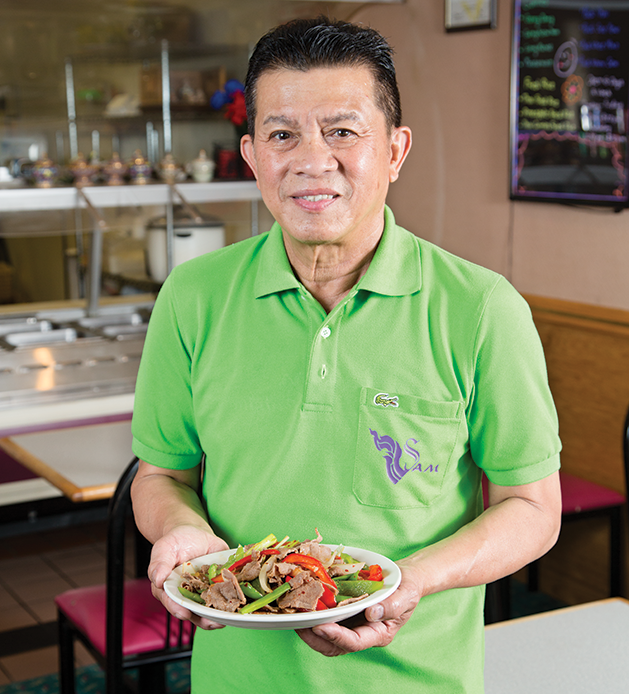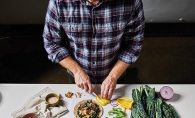
When he first opened his restaurant 17 years ago, Sam Supunniam featured Chinese food rather than food from his native Thailand. “People weren’t ready for Thai food,” he explains, “so I served Chinese food—people were already familiar with it. Then, I started to add some Thai dishes, then more. Now we are mainly Thai with some Chinese dishes on the menu.”
In addition to being a knockout chef, Supunniam is a fierce advocate of authentic Thai cuisine. He’s also a purist. He makes his own broths to ensure the best flavor, and he uses only vegetable stock so vegetarians can be assured there’s no meat hiding in any of his vegetable dishes. Even his red pepper seasoning is made from scratch—he roasts the peppers himself and then grinds it by hand to create the traditional condiment.
“My customers love the pad thai—that’s about 90 percent of my orders,” he says. A sample that Supunniam cooked up was delectable, with a slightly different taste than pad thai I’ve had elsewhere. The secret, Supunniam explains, “No fish sauce. Authentic pad thai doesn’t use fish sauce—that’s a Laotian thing. But now a lot of the younger Thai cooks use fish sauce.” What does Supunniam use for his version? He wouldn’t reveal the recipe, but he did share the ingredients for the sauce. “The sauce has to have three flavors,” says Supunniam. “You need a balance of sweet, salty and sour.” Supunniam uses tamarind paste, palm sugar, salt, rice vinegar, hot pepper and lime. “There’s no soy sauce in authentic pad thai,” Supunniam says, explaining soy sauce originated in China and has only been used in Thai cooking for the past 150 years.
In addition to creating authentic and delicious food, culinary history is important to Supunniam. “I want people to know that Sriracha sauce, that you see in all the Vietnamese restaurants, originally comes from in Thailand,” he says. Supunniam explains that the popular sauce is named after the city of Si Racha, a coastal city in eastern Thailand. According to Supunniam, a Vietnamese chef visited Thailand, became enamored of the sauce and began producing it commercially.
What’s Supunniam’s favorite dish? One is tom yom soup. “A lot of people have it when they feel like they’re getting a cold, and I have customers than come in for it whenever they have a hangover,” he says. Supunniam laughs and explains, “They say it’s the best thing to make it go away.” The soup is also a general tonic for well-being. “It’s full of antioxidants,” he says.
If you’d like to try your hand at Thai cooking at home, Supunniam recommends that beginners start with a stir-fry. Once mastered, Supunniam explains, the stir-fry is endlessly adaptable to include whatever protein or vegetables you would like.
Here are Supunniam’s tips for a perfect stir-fry:
Temperature is key. Use high heat for a short amount of time. Make sure the oil is hot enough—it should be just beginning to smoke—before adding the ingredients to the wok.
If using beef, pork or chicken, slice it about an eighth of an inch thick. Thin slices allow for rapid cooking and yields tender, juicy meat.
Add meat first. When the meat is almost cooked through add the vegetables. This ensures the vegetables will be just the right texture and not overcooked.
If you prefer tofu, Supunniam recommends a shortcut: Buy ready-to-use frozen tofu at an Asian market. Thaw it, then rinse with warm water to get rid of any excess oil. Dry well before adding to the stir-fry.
Almost any fresh vegetable is good in a stir-fry. Carrots, broccoli, green beans, snow peas and mushrooms are all good choices. Be careful to slice uniformly to ensure even cooking.
A wok is preferable if you have one; a frying pan will work if it has high sides.
Use the minimum amount of oil needed. Peanut and canola oils are good choices.
Supunniam recommends using either onion or garlic, but not both, to avoid overpowering tastes.
Use fresh, peeled ginger, about the size of half your thumb, chopped evenly.
Supunniam recommends avoiding standard soy sauce and making sure to use mushroom soy sauce, available at Asian markets. It tastes better, says Supunniam, and standard soy sauce contains high amounts of sodium, and contains wheat, making it unsuitable for those following a gluten-free diet.
For a simple sauce, add mushroom soy sauce to the wok, along with about half a teaspoon of sugar and a dash of salt. (What’s a dash? Supunniam says the amount you can hold between your thumb and index finger.)
Another tip:
If you cook rice often, buying a rice cooker is a good investment. They are available for $30–$40 and will cook white rice in 20 minutes.
Where to shop if you want to try your hand at Thai cooking? Here are Supunniam’s recommendations for stores where you can get everything you need:
Dragon Star Oriental Foods
633 W. Minnehaha Ave., St. Paul
Ha Tien Market
353 University Ave. W., St. Paul
Shuang Hur Supermarket
654 University Ave. W., St. Paul
Three essential Thai ingredients:
Galangal: A member of the rhizome family that looks similar to ginger, sometimes described as having a flavor that’s earthy, citrusy and spicy. High in antioxidants and traditionally believed to have anti-inflammatory properties.
Holy basil: Native to southeast Asia, holy basil has herbal and anise notes. High in vitamin C and potassium. In some traditions, believed to reduce anxiety, lower blood pressure and act as an adaptogen, helping the body adjust to stressors.
Kaffir lime leaves: Kaffir lime leaf’s flavor can be described as a combination of lemon, lime and orange, but with a quality all its own. Essential for tom yum soup and many curries.









